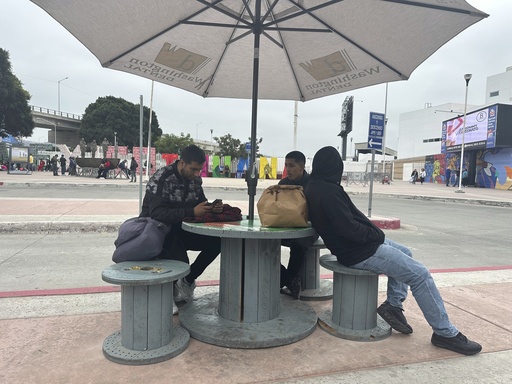MATAMOROS, Mexico (AP) — Some shelters south of the U.S. border are caring for many more migrants now that the Biden administration stopped considering most asylum requests, while others have yet to see much of a change.
The impact appears uneven more than a week after the temporary suspension took effect. Shelters south of Texas and California have plenty of space, while as many as 500 deportations from Arizona each day are straining shelters in Mexico’s Sonora state, their directors say.
“We’re having to turn people away because we can’t, we don’t have the room for all the people who need shelter,” said Joanna Williams, executive director of Kino Border Initiative, which can take in 100 people at a time.
About 120 are in San Juan Bosco shelter in Nogales, across the border from the Arizona city with the same name, up from about 40 before the policy change, according to its director, Juan Francisco Loureiro.
“We have had a quite remarkable increase,” Loureiro said Thursday. Most are Mexican, including families as well as adults. Mexico also agreed to accept deportees from Cuba, Haiti, Nicaragua and Venezuela.
A shelter in Agua Prieta, a remote town bordering Douglas, Arizona, also began receiving more Mexican men, women and children last weekend — 40 on Sunday, more than 50 on Monday and then about 30 a day. Like those sent to Nogales, most had entered the U.S. farther west, along the Arizona-California state line, according to Perla del Angel, a worker at the Exodus Migrant Attention Center.
Mexicans make up a relatively large percentage of border arrests in much of Arizona compared to other regions, which may help explain why Nogales is affected. Mexicans are generally the easiest nationality to deport because officials only have to drive them to a border crossing instead of arranging a flight.
In Tijuana, directors of four large shelters said this week that they haven’t received a single migrant deported since the asylum ban took effect. Al Otro Lado, a migrant advocacy group, consulted only seven migrants on the first full day operating an information booth at the main crossing where migrants are deported from San Diego.
“What there is right now is a lot of uncertainty,” said Paulina Olvera, president of Espacio Migrante, who houses up to 40 people traveling in families, predominantly from Mexico, and has others sleeping on the sidewalk outside. “So far what we’ve seen is the rumors and the mental health impact on people. We haven’t seen returns yet.”
Biden administration officials said last week that thousands have been deported since the new rule took effect on July 5, suspending asylum whenever arrests for illegal crossings hit a trigger of 2,500 in a single day. The officials, who briefed reporters on condition of anonymity, were not more specific. The halt will remain in effect until arrests fall below a seven-day daily average of 1,500.
“We are ready to repatriate a record number of people in the coming days,” Blas Nuñez-Neto, assistant homeland security secretary for border and immigration policy, told Spanish-language reporters after the policy was announced.
The Homeland Security Department did not immediately respond to a request for figures on Friday and neither did the National Immigration Institute in Mexico.
Mexican authorities, meanwhile, have been sweeping up unauthorized people and moving them well south of the border zone.
Mexican border cities have been heavily strained by earlier U.S. policy shifts, including the Trump-era “Remain in Mexico” plan under which about 70,000 people waited in Mexico for hearings in U.S. immigration court. Immigration advocates launched a federal challenge of the Biden administration policy change on Wednesday.
Some advocates worry that more people will languish in shelters as they try for legal entry through the CBP One app, which grants 1,450 appointments a day. Some migrants at Espacio Migrante have been trying for eight months to get an appointment on CBP One, said Olvera.
Casa del Migrante in Matamoros is now operating at about half its capacity in a network of shelters across the city that together can hold up to 1,600 people. But Berta Alicia Dominguez, its director, expects a bottleneck as more migrants compete for slots through CBP One, and she’s seeking help from the Catholic diocese and nongovernmental organizations.
“Food is going to be scarce for the migrants and we hope that the organizations can support us in that situation because feeding 500 people is a real feat,” Dominguez said.
Piedras Negras is across the border from Eagle Pass, Texas, a flashpoint in Gov. Greg Abbott’s battle with the Biden administration over immigration enforcement. Migration flows peaked there in December, when Casa del Migrante Frontera Digna housed as many as 1,000 migrants.
The shelter had fewer than 150 people on Thursday, but Isabel Turcios, the shelter director, worries about unintended consequences of exempting unaccompanied children from Biden’s order.
“We are afraid that many mothers will come and start sending their children alone. That is a big fear we have as well,” Turcios said.
___
Associated Press writers Elliot Spagat in Tijuana, Mexico, and Maria Verza in Mexico City contributed.


